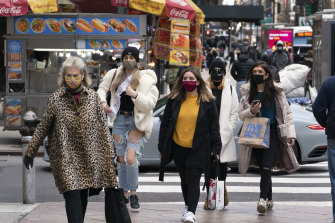Commentators friendly to the president couldn’t understand it. The economy was expanding. Unemployment was falling. But the public was unhappy about the economy and the president’s popularity kept slipping.
That’s the way things looked in 2006 to a lot of Republicans, and they concluded that the problem was that the “Bush boom” was “the greatest story never told.”
US inflation is soaring. Credit:AP
Now the bafflement has switched parties. Paul Krugman wrote in the New York Times that “the economy has been booming this year” but that gloomy news coverage has affected people’s mood about it. Neil Irwin, in the same newspaper, called it a “great contradiction” of today’s economy: “Americans are, by many measures, in a better financial position than they have been in many years. They also believe the economy is in terrible shape.” Economists may think inflation produces both winners and losers, he continued, but most people aren’t seeing it that way.
If this is really a puzzle, it’s a frequently recurring one. It happened during Barack Obama’s presidency, too. In 2014, a large majority of Americans thought the economy was in recession — a view that reporters pointed out was “flat-out wrong.”
Americans have, in fact, been pessimistic about the economy for most of the last two decades. Gallup’s “Economic Confidence Index” went negative after the dot-com boom went bust in 2000, and did not register sustained positive readings until the pre-pandemic part of President Donald Trump’s administration.
It might, then, be more instructive to examine what our last two periods of widespread happiness about the economy — throughout 1998 to 2000, and from mid-2018 to early 2020 — had in common. Both were times when the standard of living for most people was rising, and had been rising for a while.
Those conditions weren’t present in 2006 or 2014, even though the economy was growing and unemployment falling. Households in the middle of the income-distribution scale made less in 2014 than they did in 2000, after adjusting for inflation. More of the years in between saw declines than gains. Americans had not seen such a prolonged period of disappointment since this data series began in 1953. The public’s unhappiness was not irrational.
It’s not irrational now, either. Income fell in 2020 as the pandemic hit. Even if living standards were rising again, positive trends would have to continue before people began to register satisfaction. But living standards aren’t yet rising, anyway.
Wages and benefits have been moving up smartly, but only in nominal terms. As the economics researchers Jason Furman and Wilson Powell III pointed out in an analysis for the Petersen Institute, total compensation is 0.6 per cent below its December 2019 level after adjusting for inflation. Irwin wrote that economists see rising wages and rising prices as “two sides of the same coin.” For most people, though, the net effect in today’s economy is that the coins they are getting don’t go as far.
It stands to reason that changes in the real value of wages would have a bigger effect on public sentiment than changes in the unemployment rate. The number of people paying more at the pump and the grocery store is much larger than the number of people who have gotten new jobs.
It might, then, be more instructive to examine what our last two periods of widespread happiness about the economy — throughout 1998 to 2000, and from mid-2018 to early 2020 — had in common. Both were times when the standard of living for most people was rising, and had been rising for a while.
One complication in this story is that people’s financial conditions have improved, thanks to the extensive transfer payments that the federal government implemented during the pandemic. It may be, though, that people don’t see those transfers as substitutes for a continuing stream of income that they feel they are earning.
The simplest explanation for why the public thinks it’s a bad economy is that, for most people, it’s a bad economy. We don’t need to come up with a theory about the effects of modern partisanship on views of the business cycle, any more than we needed such a theory in 2006 or 2014. We need only consult the great democratic maxim: The foot knows best where the shoe pinches.
Bloomberg
The Business Briefing newsletter delivers major stories, exclusive coverage and expert opinion. Sign up to get it every weekday morning.
Most Viewed in Business
From our partners
Source: Read Full Article

